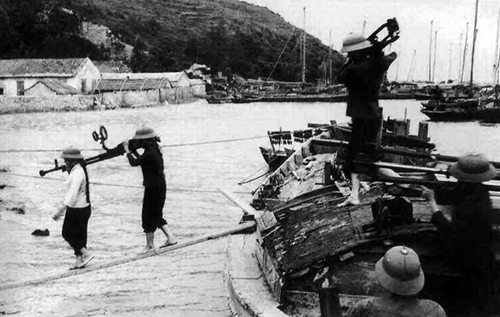During wartime, Hai Phong - the gateway seaport of the north - received aid from the Soviet Union and socialist countries. It also served as a hub for transportation by train, water, and air, which helped build socialism in the north and provide support for the south. Hai Phong was also an industrial city with a large population, owning many factories and enterprises as well as many technical facilities and defense potential.
The U.S. started its second offensive with three fierce raids using B-52s and other fighters, in combination with cruisers and destroyers. Accordingly, more than half of the city has been destroyed by thousands of shells, missiles, and hundreds of tons of bombs. In November 1972, the local armed forces and functional units implemented the people’s air defense posture. Meanwhile, the communication system and fortifications were enhanced; many radar stations and field positions were deployed. Militiamen were equipped with variety of machine guns, anti-aircraft artillery systems and vehicles. About 210,000 local people in the city were moved to other places on December 18, 1972. The whole city was ready to fight the enemy.
    |
 |
|
Hai Phong troops and people during the campaign |
On December 18, 1972, the U.S. B-52s started attacking the north. Meanwhile, dozens of B-52 Stratofortresses and many modern aircraft rushed to Hai Phong and bombarded the city with the aim to destroy it.
With a strong and brave spirit, from December 19 to 21, 1972, people and troops of Hanoi and Hai Phong closely worked together to shoot down 12 U.S. aircraft and caught many U.S. pilots alive. Knowing that the enemy would use B-52s to attack the city, on December 21, the city’s authorities decided to suspend production activities and move people to a safer place. On December 22, there were nearly 20,000 people staying on duty in the inner city.
With high determination, the air defense force in Hai Phong, especially missile regiments of Division 363 (Air Defense - Air Force Service), together with functional forces, counterattacked the enemy. As a result, Hanoi and Hai Phong troops and people shot down 17 U.S. aircraft, including four B-52s, and one F-111, with many U.S. pilots caught alive, contributing to the “Hanoi - Dien Bien Phu in the air” victory.
In order to safeguard the Fatherland early and from afar, the city focuses on building a strong and comprehensive armed forces, becoming the core and reliable force of the Party Committee, local authorities and people; and taking part in many major constructions. Meanwhile, the city’s armed forces always pioneer in the COVID-19 prevention and control, overcoming natural disaster’s consequences, search and rescue missions... contributing to promoting local socio-economic development and building whole people defense posture in line with firm people’s security posture.
During its cause of development, Hai Phong always promotes its heroic and glorious traditions, maps out solutions to mobilize the combined strength of the whole political system in socio-economic development, ensures defense and security, and builds the city’s firm defensive area.
Over the past years, Hai Phong has been one of the leading localities in the country in socio-economic development. Many traffic infrastructure facilities have been inaugurated. In addition, it has also obtained remarkable achievements in culture, society, and science and technology. Besides, social welfare as well as political security, social order, and safety have all been ensured. It has also promptly conducted Party building work and mass mobilization work. The great outcomes will enable the city to successfully implement the Resolution of the 13th Party Congress and resolutions of the Politburo, Government, and National Assembly on a number of mechanisms and policies, contributing to finalizing the goal of industrialization and modernization by 2025, and making it one of the leading modern cities in Southeast Asia by 2030 and in Asia by 2045.
Written by Vice Chairman of the Hai Phong municipal People’s Committee Le Khac Nam
Translated by Minh Anh